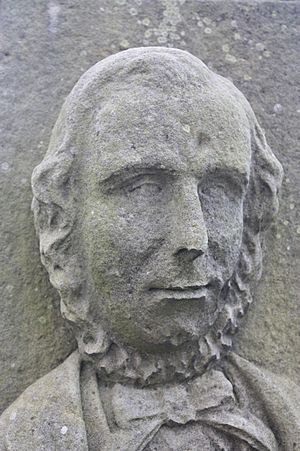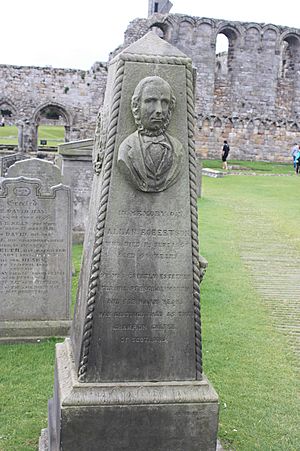Allan Robertson facts for kids
Quick facts for kids Allan Robertson |
|
|---|---|

Allan Robertson ca. 1850
|
|
| Personal information | |
| Born | 11 September 1815 St Andrews, Scotland |
| Died | 1 September 1859 (aged 43) St Andrews, Scotland |
| Nationality | |
| Career | |
| Status | Professional |
| Achievements and awards | |
| World Golf Hall of Fame | 2001 |
Allan Robertson (born September 11, 1815 – died September 1, 1859) was a very important Scottish golfer. Many people consider him to be one of the very first professional golfers.
Contents
Becoming a Golf Legend
In the mid-1800s, golf was mostly played by wealthy people. This was because golf clubs and balls were made by hand and cost a lot of money. Professional golfers like Allan Robertson earned a living in several ways:
- Playing golf matches for money or prizes.
- Working as a caddy (carrying clubs for players).
- Making golf balls and clubs.
- Teaching people how to play golf.
Allan Robertson was the most famous professional golfer of his time. It's said that he was never beaten when playing golf by himself for money. He was known as the best golfer from 1843 onwards.
Big Wins and Records
In 1843, Robertson played a huge match against Willie Dunn, Sr.. Dunn was known as the top player from Musselburgh. They played 20 rounds of golf over 10 days! Robertson won this big challenge.
He also made history on the famous Old Course at St Andrews. The year before he passed away, Robertson was the first person to score under 80 on this course. He did this while using a new type of golf ball called a "guttie."
Master Ball and Club Maker
Robertson was also considered the best at making golf balls and clubs. He sold his golf gear all over the world. This was a very profitable business, and more and more people wanted his products.
His grandfather first started the business. Then, his father took it over, and finally, Allan Robertson inherited it. Today, a golf ball with his special "Allan" stamp is very valuable to collectors.
Working with Old Tom Morris
Old Tom Morris started working as an apprentice in Robertson's shop in 1835, when he was just 14 years old. People say that Robertson and Morris were never beaten when they played golf together as partners.
A Friendly Rivalry
In 1843, Morris beat Robertson for the first time in a friendly game, winning a jacket. However, they usually didn't play against each other for big prizes. Robertson was the best player, so he could choose who he played against. He preferred Morris as his partner.
Morris was in a tricky spot because he worked for Robertson. This made it hard for them to compete against each other. For many years, Robertson and Morris had a very successful partnership playing golf.
Later, in 1853, a young star named Willie Park, Sr. beat Morris. Park then challenged Robertson to a match, but Robertson did not accept the challenge. Back then, rich people often supported these challenge matches.
Improving Golf Courses
Robertson also helped make golf courses better. He made the greens at the Old Course much larger. This was important because more people were playing golf. The Old Course has unique "double greens" that are very big.
Robertson's first work designing a golf course was at Carnoustie in 1842. He worked with Morris to create ten new holes there. Carnoustie later became one of the world's best golf courses.
The New Golf Ball
The friendship between Robertson and Morris changed when the "guttie" golf ball was invented. The guttie ball was made from a rubber-like material called gutta percha, found in Malaysia. It was much cheaper to make than the old "featherie" balls.
A Big Disagreement
Robertson found Morris playing with a guttie ball and fired him right away. Robertson tried to stop the new, cheaper ball from becoming popular. He worried it would ruin his family's business, which had been making featherie balls for 100 years.
Morris, however, understood that the guttie ball was the future of golf. He felt he had to leave Robertson and start his own workshop. In 1851, Morris moved to Prestwick in Scotland. There, he helped build a new golf course and became its professional golfer and greenkeeper.
The guttie ball completely changed golf. Robertson's featherie ball business did struggle. But Robertson quickly started making the new guttie balls himself.
Allan Robertson's Passing
Allan Robertson passed away on September 1, 1859, after becoming ill with jaundice. He was 44 years old.
The famous The Royal and Ancient Golf Club of St Andrews released a statement after his death. They praised his great contributions to golf. They also organized a yearly collection to help support his wife. Robertson's picture is proudly displayed in the Royal and Ancient Golf Club's gallery.
His grave is in the churchyard of St Andrews Cathedral. It's a stone monument with his sculpted face on it. His gravestone says: "Allan Robertson - who died 1st Sept. 1859 aged 44 years old. He was greatly esteemed for his personal worth and for many years was distinguished as the champion golfer of Scotland."
His Lasting Impact on Golf
Allan Robertson's death led to the creation of The Open Championship in golf. Since he was known as the best player for most of his life, golfers at Prestwick Golf Club started a competition in 1860. They wanted to find out who would be the next "Champion Golfer" after Robertson.
The Open Championship has been held every year since then, except during war years. It is the longest-running golf championship in the world and the oldest of the four major golf championships.
See Also
 In Spanish: Allan Robertson para niños
In Spanish: Allan Robertson para niños



